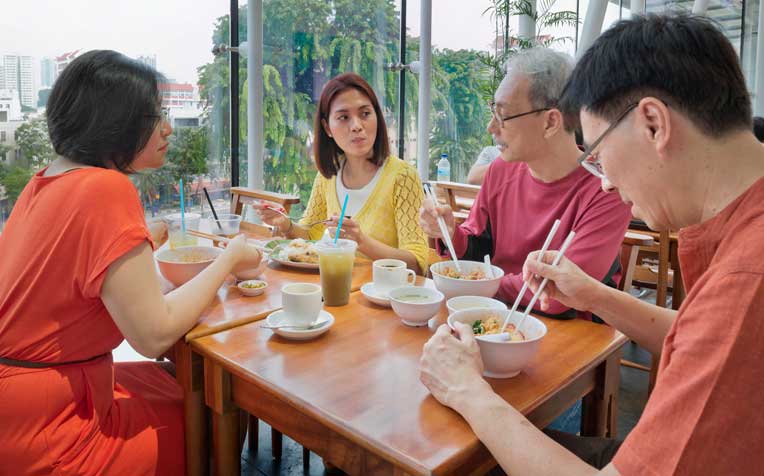
Eating out at food courts have become a way of life for most families in Singapore.
About 60% of Singaporeans eat out at least four times a week.
Most often, food court is the place to go for a quick meal if you are too tired to cook after a busy day at work. Prices are generally affordable if you compared them to the cost of ingredients for a home-cooked meal, especially when you have a small family.
A typical food court offers an average of 10-20 different types of food, ranging from local hawker (street) food to international cuisines like Western, Thai, Japanese and Korean foods to cater to the diverse population. Can you find healthier foods here?
Dietitians from the Department of Nutrition and Dietetics at KK Women's and Children's Hospital (KKH), a member of the SingHealth group, shares some simple rules when choosing your meals without the worry of weight gain.
When having Western meals...
| Choose: | Instead of: |
|---|---|
Entrée: Choose fresh salads | Coleslaw, creamy soup, meat or fried items (e.g. chicken wings, calamari rings, fries) |
Mains: Grilled, baked or pan-seared items | Deep fried or battered items (e.g. Fried chicken chop, fish and chips) |
Pasta: Tomato or olive oil based | Cream, cheese, white sauce-based |
| For sandwiches: multigrain bread, non-creamy fillings and dressings (e.g. roast chicken) | Chicken mayonnaise |
Sauce: non-creamy dressings, vinaigrette | Mayonnaise, tartar sauce etc. |
Ask about changing the French fries to baked potato (but with chives/spring onions and less sour cream and bacon bits)
When having local favourites...
- Chicken rice – ask for steamed white rice and remove the skin from the chicken.
- Avoid roti prata (pratha), puri or bhatura, but choose chapati, dosa (thosai) or idli with chickpeas and dahl (lentil) chutney instead. Omit the coconut chutney.
- Instead of lontong, mee rebus or mee siam, choose chicken macaroni soup or bee hoon soto.
When ordering drinks and desserts...
Bring own water bottle or cup to help save the earth by reducing usage of disposable cups.
Request for less sugar/evaporated milk/condensed milk in your drink, such as ‘siew dai’ or ‘kosong’ options.
Choose no added sugar pre-packaged drinks or artificially sweetened beverages.
Choose fresh fruit over fruit juice whether packaged or freshly squeezed types.
Share dessert with someone else to control intake.
To control your weight, limit fat and alcohol, and eat moderate amounts of protein and carbohydrate. For example, you can eat rice or noodles for lunch and dinner, but avoid sweet drinks and desserts.
Fill up on fibre to beat hunger by eating more vegetables, choosing brown rice over white rice, and wholemeal bread over white bread. Having a bowl of non-creamy soup at mealtimes and a moderate serving of protein (meat, fish, chicken, tofu, or beans) also fills you up with nutrients, not empty calories.
Low-calorie food options at hawker centres
1. Sliced fish soup
One of the most popular soup-based dishes available at hawker centres, choose sliced fish instead of deep-fried fish to reduce fat content and request for more vegetables to make your meal more satisfying. Avoid adding evaporated milk to make it a low-fat dish. If you are reducing your calorie intake, opt for less noodles or rice. Remember to leave your soup behind as it may contain high sodium and also be mindful with the fried shallots that you are adding to your soup.
2. Yong tau foo
Widely recognised as a light and comfort food. Choose clear soup over laksa, tom yum or dried version. Limit fried ingredients to reduce fat content, include more vegetables and replace meat items with tofu, egg or fish paste. Remember to limit your sweet sauce intake and not to finish your soup as it may contain high sodium. Ask for less noodles or rice if you are reducing your calorie intake.
3. Grilled chicken chop
Grilled chicken chop has much lower calories than fried chicken chop due to the amount of oil and batter used. You can also reduce fat content by replacing french fries with baked potato (without butter or sour cream), removing chicken skin and request for less gravy. Choose fresh salads (with non-creamy dressings) over coleslaw or you can order extra portion of salads to increase your fibre intake.
4. Mee soto
Light chicken broth with shredded chicken, beansprouts and egg. Request for beehoon instead of the usual yellow noodles; ask for additional beansprouts to increase vegetables intake and be mindful of the use of the chilli sauce (sambal kicap). You may want to skip or share that begedil (deep fried potato cake) with your food buddy to reduce fat intake and remember to avoid finishing the soup as it may contain high sodium.
5. Chapati
Another way to increase your fibre intake is to consume chapati which is made from wholemeal flour and less oily than the usual prata. Thosai can be another healthier option too as it is made from rice flour and grinded lentils. You are recommended to complete this light and healthy meal together with dhal or beans to meet your plant-based protein needs.
Ref: L20
Contributed by


















 Get it on Google Play
Get it on Google Play